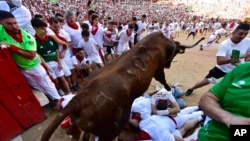Up to the mid 1970s, Luanda residents crowded the stadium's 20,000 seats to watch bullfights or "touradas" -- a violent pastime pitting man against animal that was introduced to the southern African country by its Portuguese colonizers.
Locals would form long queues to watch a bullfighter named Chibanga from Mozambique, who was a marked exception in a sport dominated by whites.
Antonio de Oliveira, head of Angola's Carnival Association, a cultural group that now occupies the premises, says that everyone wanted to see Chibanga fighting the bull.
"He was a great model because it was believed that only the white Portuguese could practice the tourada, not the Africans."
In 1975, a former Marxist liberation movement came to power and banned bullfights.
The ring became a concert venue, hosting some of the biggest names in central African music from Pepe Kalle to Koffi Olomide.
After independence in 1975, a former Marxist liberation movement, came to power and banned bullfights.
But as a lengthy and brutal civil war consumed Angola, the arena slowly fell into decay and started to draw refugees looking for shelter rather than entertainment.
Today, the neglected ring in Luanda is entered through an almost-hidden, corrugated iron gate, and steps are lined with rubbish. The air is permeated by a thick smell of urine.
Francisco, a former soldier, who came to live in the area with his family in 1998, said "We saw this abandoned space. It was in terrible conditions ... but we had no other option."
Francisco and others like him who live in cinder block houses that sprawl around the building would see their homes razed to make room for a huge parking lot if the current renovation plans were to get underway.
"After twenty years here, the government is telling us to move out. We don't have a problem with that," he says looking at the old bullring.
"One day it will be renovated" he repeats. "We are waiting."




